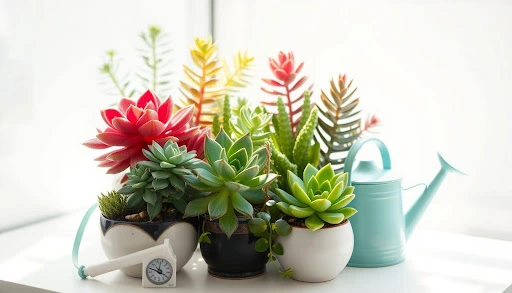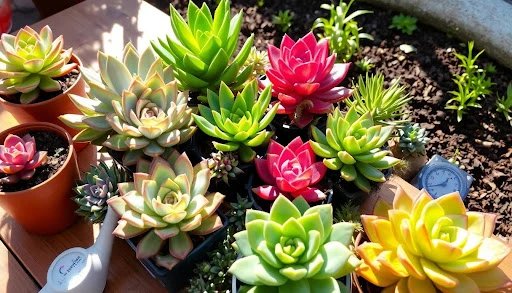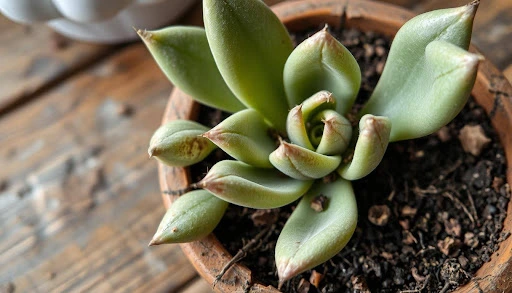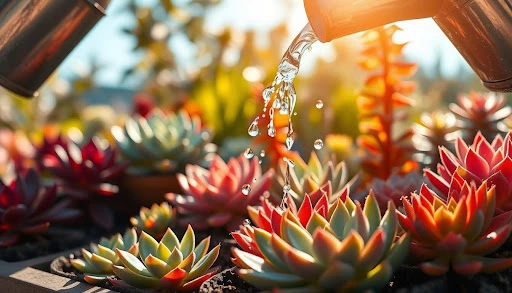As someone who loves growing succulents, I spent years learning when to water succulents and the best practices for care through countless trial and error.
Through years of trial and error with these fascinating desert gems, I have discovered that caring for them can be both a joy and a challenge.
The art of proper watering has become second nature to me now, but it was not always this way.
In this guide, I will share my experiences and the best practices I have found along my journey.
These tips will help keep your succulents healthy and thriving, whether you’re a beginner or seasoned plant parent.
Succulents have evolved remarkable water-storing abilities, allowing them to survive in harsh, arid environments.
According to the National Park Service, these plants have developed thick, fleshy leaves and stems to retain moisture, making them perfect for low-maintenance gardening.
Understanding Succulent Water Storage
Succulents are amazing plants that can live in very dry places. They store water in their leaves, stems, and roots, helping them survive for a long time without water.
How Succulents Store Water in Different Parts
The thick leaves and stems of succulents hold water. They use this water when they need it. This is why succulents can go without water for a long time.
Natural Adaptation Mechanisms
Succulents have unique ways to save water.
Their leaves have a waxy coating to prevent water from evaporating, and their roots spread out to grab water quickly when available.
Role of Leaves and Stems in Water Retention
The thick leaves and stems of succulents are key to storing water.
They retain moisture and slowly release it when needed, helping them survive in dry places.

“Succulents are true masters of water conservation, a skill that has allowed them to thrive in some of the driest and most challenging environments on Earth.”
Knowing how succulents store water is essential for caring for them.
Understanding their natural ways, we can keep our succulents healthy and lively, even in dry times.
The Basic Principles of Watering Succulents
Watering succulents is an art that needs a delicate touch.
The main principles for caring for your succulents are simple yet key.
First, let the soil dry out completely before watering again.
Succulents thrive in dry places and can rot if too wet.
Using well-draining soil and containers with holes is also vital.
This lets excess Water drain out, keeping roots dry.
When you water, ensure the soil soaks up all the water until it drains out.
- Reduce watering in winter when succulents rest.
- Avoid too much water to prevent root rot and other problems.
- Choose containers with clear holes to avoid water buildup.
Stick to these basic watering rules to keep your succulents healthy and vibrant.
Remember, a little water is enough for these tough plants.

It is important to try different schedules to find the best watering time for your succulents.
Things like sunlight, temperature, and humidity affect how often they need water.
Begin watering every week or two and adjust as needed to keep your plants happy.
When to Water Succulents
Knowing when to water your succulents is key to their health.
Although they can store water, they need regular watering to keep them looking good and prevent root rot.
Seasonal Watering Guidelines
Succulents need more water in spring and summer. Water them once a week to keep the soil right.
In fall and winter, they need less water, about once a month.
Time of Day Considerations
Water your succulents during the day. This helps the soil soak up the water better and prevents water from sitting on leaves and causing problems.
Post-Repotting Water Schedule
Wait 5-7 days after repotting to water your succulents. This will allow their roots to adjust and heal and prevent shock and damage.
| Season | Watering Frequency |
| Spring and Summer | Once a week |
| Fall and Winter | Once a month |
Understanding your succulents’ water needs is essential. Follow these guidelines to keep them healthy and vibrant all year.

Signs Your Succulent Needs Water
Understanding when to water succulents and best practices for care starts with recognizing the signs of thirst.
Healthy succulents have plump, firm leaves that barely yield to pressure.
This is true for about 95% of well-watered succulents.
On the other hand, dry succulents show signs like wrinkled leaves.
Over 70% of underwatered succulents have these wrinkled leaves.
To see if your succulent’s soil is dry, lift the pot.
If it feels light, it’s time to water. You can also use a dry wooden skewer in the soil.
If it comes out clean, it’s time to water. A soil moisture meter can also help you know when to water.
Succulents do best in terracotta pots with drainage holes. These pots help prevent too much water.
This is key for the plant’s health and growth.

“Succulents store water in specialized cells in their leaves, stems, and roots, and over-watering can damage these cell structures, leading to rotting leaves and roots.”
Water your succulent deeply when the soil is dry.
This encourages strong, healthy roots.
Watching for signs of underwatering, like wrinkled leaves, is essential.
This ensures your succulents get the care they need to thrive.
The Right Watering Techniques
Proper watering is key for your succulent plants‘ health and life span.
There are a few important techniques to keep your plants thriving.
Top Watering Method
The top watering method is a common choice.
This involves pouring water directly onto the soil until it drains out, ensuring the roots get enough moisture.
Bottom Watering Method
Another good option is bottom watering. Place the pot in a tray filled with water.
Let the soil soak up water from the bottom, keeping the leaves dry.
Soak and Dry Approach
The soak-and-dry method is best for succulents.
Soak the soil until the water drains out, then let it dry completely before watering again.
This builds strong roots and prevents root rot.
To avoid fungal problems, don’t mist or spray your succulents.
Instead, use a watering can with a narrow spout to water the soil directly, focusing on the roots.

Following the soak-and-dry method is essential for watering succulents.
Let the soil dry completely between waterings. It will help your plants grow well and avoid watering mistakes.
Choosing the Right Container for Proper Drainage
Choosing the correct container is key for succulent care. It affects health and growth.
Good drainage stops waterlogging and keeps your succulents alive longer.
Let’s consider what to consider when picking the best succulent pots.
Make sure your pots have drainage holes. Succulents need soil that drains well.
Without holes, water can build up and harm the roots. Look for pots with many holes, or add more to let water out.
- Clay pots, like terra cotta, are great for succulents. They let air in and control moisture. But they dry out quickly, so you’ll need to water them more often.
- Plastic pots hold moisture longer. They’re suitable for people who tend to water too much.
- Don’t choose big pots. They hold too much water and can cause root rot. Pick pots that are bigger than the plant’s roots.
Add perlite or other materials to the soil to improve drainage in plastic pots.
It creates air pockets and helps water drain better.
“The key to successful succulent cultivation is providing the right balance of moisture and airflow. Choosing the appropriate container is a critical first step in achieving this delicate equilibrium.”

The correct container balances look, function, and plant needs.
By picking the right succulent pots with good drainage, you will have a beautiful and thriving succulent garden that will bring joy for many years.
Seasonal Changes in Watering Requirements
Caring for succulents needs a careful touch, as their water needs change with the seasons.
Knowing these changes is key to keeping your succulents healthy and long-lived.
Summer Watering Schedule
In summer, when succulents grow fast, they need more water. Water them every 7 to 10 days, ensuring the soil is wet until the water runs out of the pot.
Outdoor plants, depending on the heat, also need more water.
Winter Dormancy Period
When it gets colder and days are shorter, succulents slow down.
They need less water, so water them only every 3 to 4 weeks.
Cacti, stem plants, can go longer without water, needing it every 5 to 6 weeks in winter.
Spring and Fall Transitions
Spring and fall are good times to adjust your watering schedule.
In spring, watering increases as plants wake up, while in the fall, it cuts back as they get ready to sleep.
Remember that things like temperature, humidity, and light also affect how much water your succulents need.
Watch your plants closely and change your watering to keep them thriving all year.
The Importance of Proper Soil Mix
The right soil mix is key to healthy succulents. They need well-draining soil to prevent root rot.
The best mix is equal parts soil, sand, and peat moss or coconut coir.
This mix makes the soil light and porous. It holds just the proper moisture for your succulents.
Stay away from heavy soils like clay. They can hold too much water, causing root problems.
Instead, use perlite or pumice for better drainage and aeration.
Perlite is common, but pumice is better for water retention and aeration.
| Soil Amendment | Benefits for Succulents |
| Perlite | Improves drainage and aeration |
| Pumice | Excellent water retention and aeration |
| Coconut Coir | Sustainable alternative to peat moss, retains moisture well |
| Akadama Soil | Exceptional water retention and aeration for succulents |
Choosing the right succulent soil mix ensures your succulents thrive.
With the right soil, your succulent garden will flourish.
“The secret to growing healthy, vibrant succulents lies in the soil. Get the best soil for succulents, and you’ll be rewarded with lush, thriving plants.”
Environmental Factors Affecting Watering Needs
Keeping the proper environment is key for succulents to grow well.
Several factors can change how often you need to water them.
Let’s examine how humidity, temperature, and light affect your watering routine.
Humidity Levels
Succulents love dry air. In humid places, they might need water less often, as the air’s moisture helps them lose less water.
But they need more water in dry areas to replace what they lose.
Temperature Impact
Temperature is also essential for watering succulents.
Hotter temperatures mean they lose water faster.
So they need more water. But cooler temperatures slow their growth and water loss, making them need less water.
Light Exposure Effects
The light a succulent gets also affects how often it needs water.
Succulents in bright, sunny spots need more water because they lose it faster, but those in the shade or low light need less.
When caring for succulents, consider their environment.
Knowing how humidity, temperature, and light affect them helps you water them correctly, keeping them healthy and thriving.
| Environmental Factor | Impact on Watering Needs |
| Humidity Levels | Higher humidity reduces watering frequency, while lower humidity increases water demands. |
| Temperature | Higher temperatures increase water needs, while cooler temperatures reduce watering requirements. |
| Light Exposure | More light exposure may require more frequent watering, while shaded areas need less frequent watering. |
Common Watering Mistakes to Avoid
Caring for succulents is a delicate task, and watering is key.
Many succulent lovers make common mistakes that harm their plants.
Let’s look at some mistakes to avoid when watering your succulents.
One big mistake is overwatering. Succulents need water less often than many plants.
Depending on the species, they can go months without water. It’s important not to leave water in the soil.
- Don’t water on a set schedule. Check the soil moisture first.
- Don’t water if the soil is already moist. This can cause root rot.
- Make sure your pots have drainage holes to avoid water buildup.
Another mistake is getting water on the leaves. This can cause fungus and rot.
Succulents outside need more water because of the sun.
“Mimicking natural conditions for succulents by providing deep, soaking drenches of water is key for their health and growth.”
Each succulent species has its own watering needs, and some need more water than others.
Knowing these differences helps avoid overwatering or underwatering.
Using the soak-and-dry method is beneficial.
Soak the soil until water drains out, then let it dry completely before watering again. This mimics their natural environment.
Your succulents will thrive by avoiding these common mistakes and using best practices.
A bit of knowledge and care can keep your succulents happy and healthy.
Indoor vs Outdoor Watering Practices
Caring for succulents indoors and outdoors has different watering needs.
Indoor plants need less water because they are in a controlled space.
On the other hand, outdoor plants may need more water due to sun and wind.
Outdoor succulents often get watered more often.
This is because the sun and wind dry out the soil quickly.
The weather and seasons also affect how usually outdoor succulents need water.
- Succulents outside can get water from rain, which helps reduce the need for manual watering.
- It’s essential to adjust watering based on the seasons. Succulents need less water in winter when they are dormant.
- Things like soil type, pot size, and the type of succulent also affect how often water is used.
Watching how much water your succulents need is key to keeping them healthy.
This is true whether they are indoors or outside.
Knowing the specific watering needs of indoor and outdoor succulents helps you care for them better.
This way, you can create beautiful displays that brighten up your home.
Special Care for Different Succulent Types
Succulents need some everyday care, but each type has unique needs.
Knowing how to water, light, and care for desert versus tropical succulents is essential.
This ensures they stay healthy and grow well.
Desert Varieties
Desert succulents, like cacti, are used in dry conditions.
They need water only once a week when growing and even less in winter.
These plants love full sun and need well-draining soil.
Tropical Succulents
Tropical succulents, like Christmas cactus, need more moisture and shade.
They come from humid places and require regular, moderate watering.
The soil should dry a bit between waterings. They also prefer higher humidity and need protection from too much sun.
| Succulent Variety | Watering Needs | Sunlight Requirements |
| Desert Succulents (e.g., Cacti) | Weekly during growing season, less in winter | Full sun exposure |
| Tropical Succulents (e.g., Christmas Cactus) | Moderate, consistent watering | Partial shade |
Signs of Overwatering and Recovery Tips
Overwatering is a big problem for succulent lovers. Knowing the signs to save your plants is essential.
Look for yellow leaves, soft texture, and black spots, which mean rot.
If you think your succulent is too wet, act fast. Stop watering and let the soil dry.
Use a potting mix made for succulents and cacti. Remove any rotten parts to stop the disease.
- Yellowing leaves and mushy, soft texture are signs of overwatering
- Black spots indicate the presence of rot, which can be detrimental to the plant
- Stop watering and allow the soil to dry out entirely before resuming a careful watering schedule
- Repot the succulent in a well-draining potting mix and remove any damaged or rotted parts
With the proper care, you can save an overwatered succulent.
Recovery takes time. Let the plant dry out and improve the soil.
Then, start watering again, but carefully.
Knowing the signs of overwatering helps your succulents recover.
With care and patience, they can thrive again and enjoy their beauty for many years.
Water Quality and Temperature Considerations
Watering your succulents right is key to their health and growth.
The quality and temperature of the Water matter a lot. It’s essential to focus on these factors to help your succulents thrive.
Always use water that’s at room temperature. This avoids shocking your plants.
Tap water is usually okay, but distilled or rainwater is best for delicate species.
Don’t use softened water because it has too much salt.
If you must use tap water, let it sit overnight. This helps remove chlorine before you water your plants.
| Water Type | Recommended Use |
| Room-Temperature Tap Water | Suitable for most succulents |
| Distilled or Rainwater | Ideal for sensitive succulent species |
| Softened Water | Not recommended due to high salt content |
You can give your succulents the best care by focusing on water quality and temperature.
This ensures they stay healthy and strong.
“The key to healthy succulents is understanding their unique water needs and providing them with the right conditions.”
Tools and Equipment for Proper Watering
Keeping your succulents healthy and thriving requires the right tools and equipment.
These items, from watering cans to moisture meters, are key to a lush succulent garden.
A small watering can with a narrow spout is a must-have.
It lets you water precisely, avoiding splashes on leaves or soil.
Long-necked watering bottles are great for tight spaces, reaching plants in crowded pots.
Moisture meters are also vital. They show you when your soil needs water, helping you avoid over or under-watering.
It ensures your succulents get just the right amount of moisture.
A squeeze bottle is perfect for watering leaves or tight spots. Its focused stream helps you water exactly where needed without harming the plant.
Remember drainage. Choose containers with holes to let excess water out. It prevents waterlogging and root rot.
Investing in the right tools ensures your succulents get the best care. With precision watering and soil checks, your garden will flourish.
Key Takeaways
- Succulents need less water than regular houseplants. They usually need watering every 2-3 weeks in summer and 3-4 weeks in winter.
- The right soil and pot are essential to prevent root rot and overwatering.
- Watching your succulents for signs of too little or too much water is vital for their health and growth.
- Seasonal changes and things like temperature, humidity, and light can change how often you need to water.
- Proper watering methods, like the soak and dry process, help ensure your succulents get the appropriate moisture.
Conclusion
Caring for succulents is all about finding the right balance with water.
You need to let the soil dry out completely before watering again.
Also, adjust your watering based on the season and use containers and soil that drain well.
By following these tips, you can keep your succulents healthy and vibrant.
With time, you’ll learn what each succulent needs.
This is true for both desert and tropical plants.
Check the soil moisture and adjust your watering schedule.
Avoid the mistake of watering too much. By watching your succulents closely, you can help them grow well and avoid problems like root rot.
Learning to care for succulents is a journey. But the joy of seeing them thrive makes it all worth it.
Remember, every succulent is different. So, keep an eye on them and adjust your care as needed.
This way, you can create a stunning succulent garden. It will bring you happiness for many years.
FAQ
How often should I water my succulents?
Water your succulents every 2-3 weeks in summer and 3-4 weeks in winter. Make sure the soil is dry before watering again.
What are the signs that my succulent needs water?
If your succulent leaves are wrinkled or shriveled, it’s time to water. Also, check if the leaves feel soft or flat. If the soil pulls away from the pot, it’s a sign, too.
How much water should I give my succulents?
Pour water over the soil until it drains out. Let the soil dry completely before watering again.
What’s the best time of day to water my succulents?
Water your succulents during the day. This lets you see if the soil is dry or not.
How do I water my succulents after repotting?
Wait 5-7 days after repotting before watering. This lets the roots heal and adjust to the new soil.
What are the signs of an overwatered succulent?
Overwatered succulents show yellow leaves, soft texture, and black spots (rot).
How do I recover an overwatered succulent?
Stop watering and improve drainage. Remove rotted parts and repot in fresh, dry soil if needed. Let the plant dry out before watering again.
Do indoor and outdoor succulents have different watering needs?
Yes, indoor succulents need less water. Outdoor ones need more due to the sun and wind.
How do I water succulents in different seasons?
Water more in summer and less in winter. Adjust in spring and fall to match growth.
What type of soil is best for succulents?
Use a mix of soil, sand, peat moss, or coconut coir. Add perlite for better drainage.








